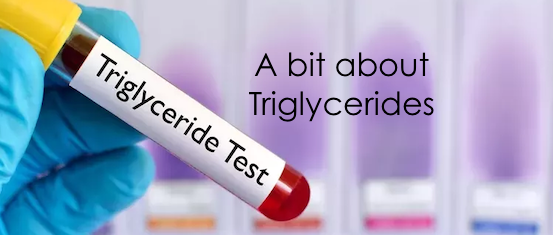Today’s post is about triglycerides.
The last post was about Cholesterol and the associated blood test.
As mentioned in that post, the measured total cholesterol level is made up of LDL cholesterol, HDL cholesterol and 20% of triglycerides.
So today I thought that in this post I would explore that 20%, the triglycerides.
What are triglycerides?
Triglycerides are the most common type of fat that circulates in the blood and are a critical source of energy. The body gets triglycerides or makes them from the foods we eat. The body converts any calories it doesn’t need to use right away into triglycerides. As a normal component of the vascular system, triglycerides are continuously being circulated just in case they need to be converted to energy.
When there is an excess of triglycerides in the body, they can be stored in the liver or in fat cells to supply the body with energy when it is required. This is a natural process that provides a sustained source of energy for the body, particularly between meals, as triglycerides are a stored energy source.
When more calories are consumed than burned, particularly from high-carbohydrate foods, this can cause high triglycerides (hypertriglyceridemia).
If the level of triglycerides is high and this is combined with a high LDL level or a low HDL level, there is a higher risk of fat building up and blocking blood vessels. This increases the risk of heart attack or a stroke.
What is normal?
A doctor or health professional will usually check for high triglycerides as part of a cholesterol test, which is sometimes called a lipid panel or lipid profile. Fasting is required before any blood can be drawn for an accurate measurement.
Normal fasting blood triglyceride levels are:
*Lower than 150 milligrams per deciliter (mg/dL) for adults
*Lower than 90 mg/dL for children ages 10 to 19
The doctor may diagnose high blood triglycerides if the fasting blood triglyceride levels are consistently 150 mg/dL or higher.
*Borderline high — 150 to 199 mg/dL
*High — 200 to 499 mg/dL
*Very high — 500 mg/dL or above
A high triglyceride level is one of the signs of metabolic syndrome. This is a collection of health conditions that increase risk of cardiovascular disease and diabetes.
An extremely high triglyceride level can cause inflammation of the pancreas, the organ in the abdomen that produces insulin.
Accordingly, people who have high levels of triglycerides should be advised to reconsider their diet and any habits of overeating in order to lower their triglyceride levels and reduce their risk of these conditions.
Some individuals may also have high triglyceride levels due to other circumstances. These could be excessive alcohol consumption, uncontrolled diabetes, hormonal abnormalities, kidney or liver disease, as a result of a genetic disorder or the use of certain medications. If this is the case, the primary cause should be managed appropriately in order to manage the triglyceride levels.
How can we lower our levels?
As with most health issues, small changes including diet can reduce triglyceride levels.
These can be simple changes such as;
*Eating a diet rich in fruit, vegetables, whole-grains and healthy proteins (especially fish) will help to lower levels.
*Including healthy fats in the diet and reducing the unhealthy fats.
*Cut back on drinks and foods made from sugar and white flour.
*Cut back on alcohol.
* Exercise regularly.
* And lose weight, if overweight.
If you have diabetes, make sure your blood sugar level is well controlled.
As always, seek help from your chosen health professional if you are concerned about your triglyceride or cholesterol levels.
We hope you have found this information interesting,
Till the next post,
Live clean n prosper
Sources – National Heart, Lung and Blood Institute – Mayo Clinic – Health Direct


